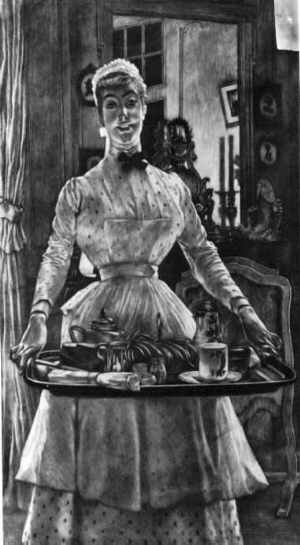 LE MATIN-THE MORNING.
LE MATIN-THE MORNING.JAMES TISSOT 1836 - 1902
James Jacques Joseph Tissot is born in Nantes (France) on October 15, 1836.
He studied with Lamotte and Flandrin, he began to exhibite his works at the Salon of 1859 in Paris.
In 1861, his painting" Faust and Marguerite " was bought by the French State.
His portraits of women put him as a "mundane" painter.
He began to experiment with etching about 1860.
After the Franco-Prussian war of 1870, he settled in England.
His etchings with Victorien charm became very fashionnable.
Despite his successes, he moved to Palestine and spent ten years working on the pictures of the life of Christ.
Finally, he retired in the abbey of Bouillon (Doubs, France) where he died in 1902.
Tissot has published a catalogue of his prints in 1886. In the introduction, Charles Yriarte wrote : "The artist does not abandon his plate when the work is finished; another function remains to be fulfilled; he chooses his ink, and the quality of his paper; he sets up his apparatus; he transforms his studio; he installs his presses, and looking directly after the printing, makes (so to speak) a personnal work of each one of the proofs, which he might sign twice, as etcher and as printer."
Except in the cases of the early Louise W3 and the late mezzotints (W75, W76, W82 Le Matin, W83) Tissot is not known to have used "chine appliqué" for his prints.
" The proofs which remains, much sought for by amateurs, will soon become unobtainable." wrote Yriarte who prefaced the 1886 catalogue.
 LE MATIN-THE MORNING.
LE MATIN-THE MORNING.
Tissot painted a series of large paintings devoted to the charms of foreign women. Two pictures were completed by the time of the exhibition at the Galerie Sedelmeyer. A third one "Sur la tamise" is called todays "Return from Henley". Le Matin is close in feeling to Return from Henley, part of this series to be called L'étranger, and it seems probable that Le matin is in fact a half-lenght version of an unlocated picture. A photograph of an unlocated watercolor attests a possible second version showing the figure of a man at breakfastat the lower right and the figure of a girl three-quater lenght in the manner of Le Matin.
Mezzotint 1886. Wenworth 82.
Very good impression on "chine appliqué".
Dimensions : plate 26 * 49 , sheet 55 * 72,5 cm.
Very popular, Tissot's prints were bought by the English public, great gourmands of this sort of work, catching up the proofs without looking at the price. But the Vente Tissot in 1903 was the first time his prints came on the market in bloc and it became some material for the second hand dealer; only a few eccentric collectors kept interest for this pictures with nostalgic charm. The exhibition at the Leicester Galleries brought a new interest in his works. The recognition was crowned with the exhibition given at Sheffield in 1955. In 1968, the retrospective exhibition in Toronto contributed to his remergence. Todays, the taste for Tissot's prints, very wanted by collectors, is really increasing.
"Tissot's prints are in many ways the most rewarding part of his work." wrote Wentworth in the catalogue raisonné of his prints.
First state, before lettering.
With the title margin cleaned but blank, signed in drypoint, lower right.
Tissot 87 Béraldi 73 wentworth 82

Second state, with lettering.
Tissot 88 Béraldi 73 wentworth 82

BIBLIOGRAPHY:
James Tissot "Eaux-fortes,manière noire, pointes sèches." Paris 1886.
Henri Béraldi "Les graveurs du 19ième siècle". Paris vol 12.
Michael Justin Wenworth "James Tissot catalogue raisonné of his prints". Minneapolis 1978.
![]() Other artists.
Other artists.